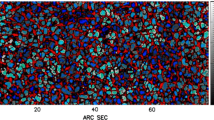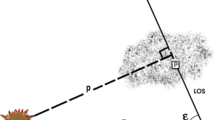Abstract
We investigate the properties of acoustic events (AEs), defined as spatially concentrated and short duration energy flux, in the quiet Sun, using observations of a 2D field of view (FOV) with high spatial and temporal resolution provided by the Solar Optical Telescope (SOT) onboard Hinode. Line profiles of Fe i 557.6 nm were recorded by the Narrow-band Filter Imager (NFI) on a 82″×82″ FOV during 75 min with a time step of 28.75 s and 0.08″ pixel size. Vertical velocities were computed at three atmospheric levels (80, 130, and 180 km) using the bisector technique, allowing the determination of energy flux to be made in the range 3 – 10 mHz using two complementary methods (Hilbert transform and Fourier power spectrum). Horizontal velocities were computed using local correlation tracking (LCT) of continuum intensities providing divergences. We found that the net energy flux is upward. In the range 3 – 10 mHz, a full FOV space and time averaged flux of 2700 W m−2 (lower layer 80 – 130 km) and 2000 W m−2 (upper layer 130 – 180 km) is concentrated in less than 1 % of the solar surface in the form of narrow (0.3″) AE. Their total duration (including rise and decay) is of the order of 103 s. Inside each AE, the mean flux is 1.6×105 W m−2 (lower layer) and 1.2×105 W m−2 (upper). Each event carries an average energy (flux integrated over space and time) of 2.5×1019 J (lower layer) to 1.9×1019 J (upper). More than 106 events could exist permanently on the Sun, with a birth and decay rate of 3500 s−1. Most events occur in intergranular lanes, downward velocity regions, and areas of converging motions.










Similar content being viewed by others
References
Altrock, R.C., November, L.J., Simon, G.W., Milkey, R.W., Worden, S.P.: 1975, Solar Phys. 433, 33.
Bello González, N., Flores Soriano, M., Kneer, F., Okunev, O.: 2009, Astron. Astrophys. 508, 941.
Bello González, N., Flores Soriano, M., Kneer, F., Okunev, O., Schukina, N.: 2010a, Astron. Astrophys. 522, A31.
Bello González, N., Franz, N., Martinez Pillet, V., Bonet, J.A., Solanki, S.K., del Toro Iniesta, J.C., et al.: 2010b, Astrophys. J. Lett. 723, L134.
Berilli, F., Consolini, G., Pietropaolo, E., Caccin, B., Penza, V., Lepreti, F.: 2002, Astron. Astrophys. 381, 253.
Brown, T.M.: 1991, Astrophys. J. 371, 396.
Gingerich, O., Noyes, R.W., Kalkofen, W., Cuny, Y.: 1971, Solar Phys. 18, 347.
Goode, P., Gough, D., Kosovichev, A.: 1992, Astrophys. J. 387, 707.
Ichimoto, K., Tsuneta, S., Suematsu, Y., Shimizu, T., Otsubo, M., Kato, Y., et al.: 2005, In: Mather, J.C. (ed.) Optical, Infrared, and Millimeter Space Telescopes, Proc. SPIE 5487, 1142.
November, L.J., Simon, G.W.: 1988, Astrophys. J. 333, 427.
Rast, M.P.: 1999, Astrophys. J. 524, 462.
Rimmele, T.R., Goode, P.R., Harold, E., Stebbins, R.T.: 1995, Astrophys. J. Lett. 444, L119.
Roudier, T., Lignières, F., Rieutord, M., Brandt, P.N., Malherbe, J.M.: 2003, Astron. Astrophys. 409, 299.
Rutten, R.J., van Veelen, B., Sütterlin, P.: 2008, Solar Phys. 251, 533.
Shelyag, S., Erdélyi, R., Thompson, M.J.: 2006, Astrophys. J. 651, 576.
Skartlien, R., Stein, R.F., Nordlund, A.: 2000, Astrophys. J. 541, 468.
Stebbins, R., Goode, P.R.: 1987, Solar Phys. 110, 237.
Stein, R.F., Nordlund, A.: 2001, Astrophys. J. 546, 585.
Stein, R.F., Georgobiani, D., Trampedach, R., Ludwig, H., Nordlund, A.: 2004, Solar Phys. 220, 229.
Strous, L.H., Goode, P.R., Rimmele, T.R.: 2000, Astrophys. J. 535, 1000.
Suematsu, Y., Tsuneta, S., Ichimoto, K., Shimizu, T., Otsubo, M., Katsukawa, Y., et al.: 2008, Solar Phys. 249, 197.
Title, A.M., Tarbell, T.D., Topka, K.P., Ferguson, S.H., Shine, R.A., The SOUP team: 1989, Astrophys. J. 336, 475.
Acknowledgements
We are grateful to the anonymous referee for helpful comments and suggestions and to R. Stein for useful hints. We are also indebted to the Hinode team for the possibility to use their data. Hinode is a Japanese mission developed and launched by ISAS/JAXA, collaborating with NAOJ as a domestic partner, NASA and STFC (UK) as international partners. Scientific operation of the Hinode mission is conducted by the Hinode science team organized at ISAS/JAXA. This team mainly consists of scientists from institutes in the partner countries. Support for the post-launch operation is provided by JAXA and NAOJ (Japan), STFC (U.K.), NASA, ESA, and NSC (Norway).
This work was supported by the Centre National de la Recherche Scientifique (C.N.R.S., UMR 8109 and 5572) and by the Programme National Soleil Terre (P.N.S.T.), France.
Author information
Authors and Affiliations
Corresponding author
Electronic Supplementary Material
Below are the links to the electronic supplementary material.
Appendix
Appendix
In order to compute the complex signal \(V(t) = v(t) + \mathrm{i}\underline{v}(t)\), we used the temporal FFT together with the following properties of the Hilbert transform (HT). Given an observed signal v(t), the HT \(\underline{v}(t)\) is given by
where ⋆ denotes the convolution product and \(h(t)= \frac{1}{\pi t}\).
For a sinusoidal signal of the form v(t)∝cos(ωt+φ), the HT is simply \(\underline{v}(t) \propto\sin(\omega t + \varphi)\), so that in this case V(t)∝exp[i(ωt+φ)].
The easiest way to get \(\underline{v}(t)\) is to use the Fourier transform (FT with u denoting the temporal frequency):
It can easily be shown that
where \(\operatorname{sgn}(u) \) is the sign function, +1 for u>0, 0 for u=0 and −1 for u<0.
As a consequence, the FT of the complex signal \(V(t) = v(t) + \mathrm{i}\underline{v}(t)\) is given by
This expression reduces simply to
-
i)
u<0,FT V (u)=0,
-
ii)
u=0,FT V (u)=FT v (u),
-
iii)
u>0,FT V (u)=2FT v (u).
We first computed the temporal FT of the observed signal v(t); in order to get the FT of the complex velocity \(V(t) = v(t) + \mathrm{i}\underline{v}(t)\), values corresponding to negative frequencies were eliminated and values corresponding to positive frequencies were doubled. Finally, the complex velocity \(V(t) = v(t) + \mathrm{i}\underline{v}(t)\) was derived from the inverse FT.
Rights and permissions
About this article
Cite this article
Malherbe, JM., Roudier, T., Rieutord, M. et al. Acoustic Events in the Solar Atmosphere from Hinode/SOT NFI Observations. Sol Phys 278, 241–256 (2012). https://doi.org/10.1007/s11207-012-9954-3
Received:
Accepted:
Published:
Issue Date:
DOI: https://doi.org/10.1007/s11207-012-9954-3




